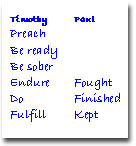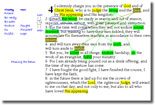

putting
it all
together


How To Study Inductively
Overview
Mark the Text
There are many ways to do this. I like to use colored pencils. You can find some at an office supply. I have a pack of 12 colored pencils by Berol. They have a soft lead and wear down easily (require a lot of sharpening), but they also show up better than the harder colored pencils. Also, "highlighters" can be used, but bleed through to the other side of the page on the type of paper used in many Bibles.
Let's look in some example text in 2 Timothy 4:1-8. This is one paragraph with many elements that allow for the demonstration of inductive techniques.
Verse 1 "I solemnly charge you in the presence of God and of Christ Jesus, who is to judge the living and the dead, and by His appearing and His kingdom:"
Always mark the words God, Christ, Holy Spirit, Jesus, LORD, and any other Names of God. You may want to choose a certain color for the Names of God. I like to mark with a yellow pencil. Or, you may choose to mark with a symbol of some kind over the word you are marking. For instance, over the word Christ, you could draw a red cross. The idea is not to be overly concerned on what kind of marking method to use, but that the text is marked.
Let's continue and make comments as we go along. You have hopefully marked God and Christ Jesus in verse 1. Go to verse 8 and mark LORD and Judge. We are marking Judge because the context points to a particular kind of judge, a righteous judge. This is a reference to Christ and is being used as a Name of God.
Go back to verse 1. The word judge appears here, too. Notice how judge now becomes a key to understanding the paragraph. The phrase that is connected to judge is "the living and the dead". In verse 8, Christ is called the Righteous Judge. So, at the beginning of the paragraph we have what Christ is to do. At the end of the paragraph, we have Who He is.
Further, another element that you always want to look for is that of contrast. Contrast is one of the laws of composition employed by the Author of a particular work of literature. It is also the easiest to identify. We deal with it every day. It is the use of opposites, like hot and cold, black and white, tall and short, etc. In verse 1, we have living and dead. Anytime you come across living, Life, alive or dead, Death,and dying in Bible study, it is time to give attention. Life and Death are themes that are played out all through the Bible and completely demonstrate the law of contrast.
Mark living with a lively color. I use green. Mark dead with a not so lively color, like brown. Since the paragraph begins with contrast, that is a clue to look for more. Look through the rest of the paragraph.
Do you see any other instances? Perhaps not side-by-side. So, let's look at it a different way. Let's look and see what words are words that are characteristic of life and of death. How about in verse 5, the word sober (watch-KJV, watchful-NKJV)? This is representative of life, is it not? How about words that represent death? Nothing really stands out, yet. So, let's dig a little deeper...
Paul, in verse 5, after instructing Timothy to be sober, continues with endure, do, and fulfill (make full proof-KJV). These three verbs indicate life and living, so mark them.
Notice in verse 2, Paul tells Timothy to preach the word. The phrase, "the word" appears often in the Bible. In this case, the context indicates more about "the word" and who will hear the word and what they will do with the word. Jesus, in Mark 2, preached the word to those in the house at Capernaum. In John 6:68, Peter confesses that Jesus has the words of eternal life.
The phrase "word of life" appears over 400 times in the Bible. So, let's revisit our paragraph and look for instances where word and living are represented. Look at verses 3 and 4 - mark the word, sound doctrine and truth in green. Now, in relation to the dead, look at verses 3 and 4 again - mark desires (lusts-KJV) and myths (fables-KJV) in brown.
Now, did you notice that the phrase "His appearing", in verse 1, is repeated in verse 8? Since this phrase is repeated in the same paragraph, and especially because it is placed at the beginning and the end of the paragraph, it warrants being marked.
At this time, we will sort of connect the dots. With your green pencil, draw a line from living, in verse1, to sober, in verse 5. Draw similar lines from living to endure, do, and fulfill, in verse 5. Also, draw lines from the word in verse 2 to sound doctrine, in verse 3 and truth, in verse 4. Then, with your brown pencil, draw a line from dead, in verse 1 to desires, in verse 3 and myths, in verse 4. Be patient, more will come to light in a moment.
Let's examine verses 5-7. In verse 5, Paul is giving Timothy some instructions. By reading the context, especially verse 6, we see what kind of instructions that Timothy is receiving—final ones. Paul is ready to go on to his reward and he wants Timothy to carry on. Paul has done what he expects Timothy to do. In verse 7, he says, "I have fought the good fight, I have finished the course, I have kept the faith;". Paul tells Timothy to endure hardship, in verse 5. In verse 7, Paul says he, himself, has fought the good fight. Is not enduring hardship as an evangelist the same as fighting the good fight? See how Paul urges Timothy on by asking him to do nothing he did not himself do? Doing the work of an evangelist and fulfilling the ministry is the course that Paul has finished and the faith he has kept.
In between verses 5 and 7 is verse 6. Paul is seeing the time of his departure. His language here and in verse 7, especially the phrase, "finished the course" is like that of a runner in a race. Paul is passing the baton, like a relay runner, to the next runner, Timothy. This runner in a race language continues in verse 8, in the phrase, "crown of righteousness", which is what Paul and every faithful Christian will receive. Verse 6 illustrates another literary technique- transition. Paul is talking about Timothy in verse 5 and himself in verse 7. So, in the margin next to verse 6, write the words "passing the baton".
Lists
Here is where the wide margin Bible will come into play. If you have the room in your margin, you can make a list. They are very good for drawing your eyes to the significant truths that you discovered in previous studies. In this case, a list can be made like a side-by-side table with Paul heading one column and Timothy heading the other. Something like this:
References to Time
Always mark references to time. Notice in verse 2, when Paul says, "preach the word", the unspoken encouragement is "NOW". In verse 3, we can see this better, when Paul says, "For the time will come...". Clearly this is a reference to the future. If you are a Mac person (are there any left?), you may want to draw that "watch" cursor icon next to verses 2 and 3. If you are a Windows person (is there anything else?), you may want to draw an hourglass. Or, if you are normal, you may want to draw a ???. Something that will tell you that this is a reference to time. Maybe like this:
So far your page should look something like this:
Click to see full size image...
Proceed to find out how to make the Analytical Chart.


